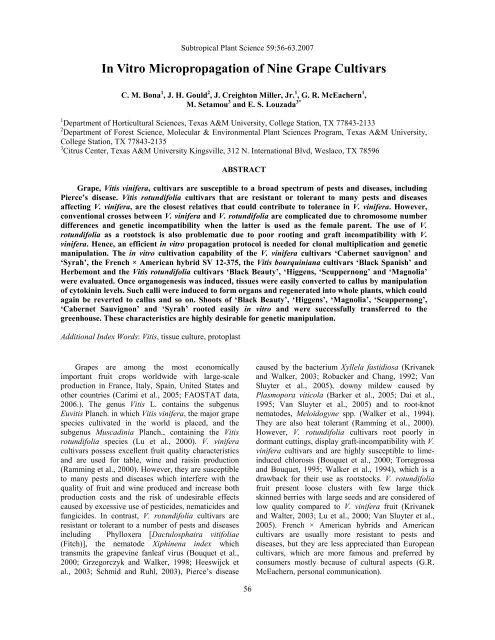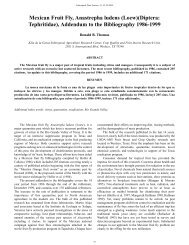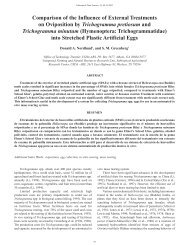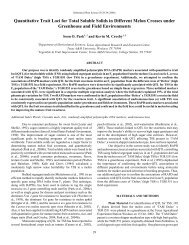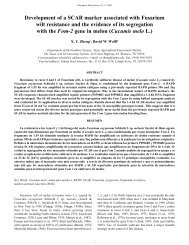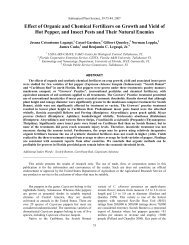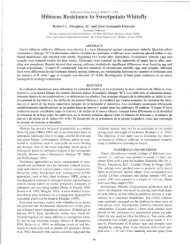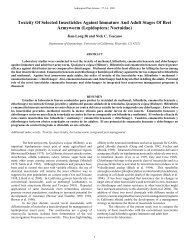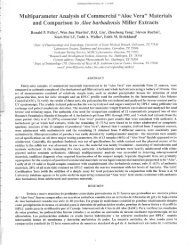In Vitro Micropropagation of Nine Grape Cultivars - Subtropical Plant ...
In Vitro Micropropagation of Nine Grape Cultivars - Subtropical Plant ...
In Vitro Micropropagation of Nine Grape Cultivars - Subtropical Plant ...
Create successful ePaper yourself
Turn your PDF publications into a flip-book with our unique Google optimized e-Paper software.
<strong>Subtropical</strong> <strong>Plant</strong> Science 59:56-63.2007<br />
<strong>In</strong> <strong>Vitro</strong> <strong>Micropropagation</strong> <strong>of</strong> <strong>Nine</strong> <strong>Grape</strong> <strong>Cultivars</strong><br />
C. M. Bona 1 , J. H. Gould 2 , J. Creighton Miller, Jr. 1 , G. R. McEachern 1 ,<br />
M. Setamou 3 and E. S. Louzada 3*<br />
1 Department <strong>of</strong> Horticultural Sciences, Texas A&M University, College Station, TX 77843-2133<br />
2 Department <strong>of</strong> Forest Science, Molecular & Environmental <strong>Plant</strong> Sciences Program, Texas A&M University,<br />
College Station, TX 77843-2135<br />
3 Citrus Center, Texas A&M University Kingsville, 312 N. <strong>In</strong>ternational Blvd, Weslaco, TX 78596<br />
ABSTRACT<br />
<strong>Grape</strong>, Vitis vinifera, cultivars are susceptible to a broad spectrum <strong>of</strong> pests and diseases, including<br />
Pierce’s disease. Vitis rotundifolia cultivars that are resistant or tolerant to many pests and diseases<br />
affecting V. vinifera, are the closest relatives that could contribute to tolerance in V. vinifera. However,<br />
conventional crosses between V. vinifera and V. rotundifolia are complicated due to chromosome number<br />
differences and genetic incompatibility when the latter is used as the female parent. The use <strong>of</strong> V.<br />
rotundifolia as a rootstock is also problematic due to poor rooting and graft incompatibility with V.<br />
vinifera. Hence, an efficient in vitro propagation protocol is needed for clonal multiplication and genetic<br />
manipulation. The in vitro cultivation capability <strong>of</strong> the V. vinifera cultivars ‘Cabernet sauvignon’ and<br />
‘Syrah’, the French × American hybrid SV 12-375, the Vitis bourquiniana cultivars ‘Black Spanish’ and<br />
Herbemont and the Vitis rotundifolia cultivars ‘Black Beauty’, ‘Higgens, ‘Scuppernong’ and ‘Magnolia’<br />
were evaluated. Once organogenesis was induced, tissues were easily converted to callus by manipulation<br />
<strong>of</strong> cytokinin levels. Such calli were induced to form organs and regenerated into whole plants, which could<br />
again be reverted to callus and so on. Shoots <strong>of</strong> ‘Black Beauty’, ‘Higgens’, ‘Magnolia’, ‘Scuppernong’,<br />
‘Cabernet Sauvignon’ and ‘Syrah’ rooted easily in vitro and were successfully transferred to the<br />
greenhouse. These characteristics are highly desirable for genetic manipulation.<br />
Additional <strong>In</strong>dex Words: Vitis, tissue culture, protoplast<br />
<strong>Grape</strong>s are among the most economically<br />
important fruit crops worldwide with large-scale<br />
production in France, Italy, Spain, United States and<br />
other countries (Carimi et al., 2005; FAOSTAT data,<br />
2006.). The genus Vitis L. contains the subgenus<br />
Euvitis Planch. in which Vitis vinifera, the major grape<br />
species cultivated in the world is placed, and the<br />
subgenus Muscadinia Planch., containing the Vitis<br />
rotundifolia species (Lu et al., 2000). V. vinifera<br />
cultivars possess excellent fruit quality characteristics<br />
and are used for table, wine and raisin production<br />
(Ramming et al., 2000). However, they are susceptible<br />
to many pests and diseases which interfere with the<br />
quality <strong>of</strong> fruit and wine produced and increase both<br />
production costs and the risk <strong>of</strong> undesirable effects<br />
caused by excessive use <strong>of</strong> pesticides, nematicides and<br />
fungicides. <strong>In</strong> contrast, V. rotundifolia cultivars are<br />
resistant or tolerant to a number <strong>of</strong> pests and diseases<br />
including Phylloxera [Dactulosphaira vitifoliae<br />
(Fitch)], the nematode Xiphinena index which<br />
transmits the grapevine fanleaf virus (Bouquet et al.,<br />
2000; Grzegorczyk and Walker, 1998; Heeswijck et<br />
al., 2003; Schmid and Ruhl, 2003), Pierce’s disease<br />
caused by the bacterium Xyllela fastidiosa (Krivanek<br />
and Walker, 2003; Robacker and Chang, 1992; Van<br />
Sluyter et al., 2005), downy mildew caused by<br />
Plasmopora viticola (Barker et al., 2005; Dai et al.,<br />
1995; Van Sluyter et al., 2005) and to root-knot<br />
nematodes, Meloidogyne spp. (Walker et al., 1994).<br />
They are also heat tolerant (Ramming et al., 2000).<br />
However, V. rotundifolia cultivars root poorly in<br />
dormant cuttings, display graft-incompatibility with V.<br />
vinifera cultivars and are highly susceptible to limeinduced<br />
chlorosis (Bouquet et al., 2000; Torregrossa<br />
and Bouquet, 1995; Walker et al., 1994), which is a<br />
drawback for their use as rootstocks. V. rotundifolia<br />
fruit present loose clusters with few large thick<br />
skinned berries with large seeds and are considered <strong>of</strong><br />
low quality compared to V. vinifera fruit (Krivanek<br />
and Walter, 2003; Lu et al., 2000; Van Sluyter et al.,<br />
2005). French × American hybrids and American<br />
cultivars are usually more resistant to pests and<br />
diseases, but they are less appreciated than European<br />
cultivars, which are more famous and preferred by<br />
consumers mostly because <strong>of</strong> cultural aspects (G.R.<br />
McEachern, personal communication).<br />
56
<strong>Subtropical</strong> <strong>Plant</strong> Science 59:56-63.2007<br />
Hybridizations between V. vinifera and V.<br />
rotundifolia have been successfully performed<br />
(Bouquet et al., 2000; Firoozabady and Olmo, 1982;<br />
Lu at al., 2000; Olmo, 1971; Ramming et al., 2000)<br />
mainly when V. rotundifolia is used as the male<br />
parent. However, production <strong>of</strong> hybrids is usually low<br />
and exhibit poor fertility (Bouquet et al., 2000; Dai et<br />
al., 1995). Such results are probably due to the<br />
difference in chromosome number, (2n = 40) in V.<br />
rotundifolia and (2n = 38) in V. vinifera (Schmid and<br />
Ruhl, 2003; Xu and Lu, 2004; Wang et al., 1999).<br />
Hybridization using V. rotundifolia as female parent is<br />
problematic because germinating V. vinifera pollen<br />
usually fails to reach the V. rotundifolia embryo sac.<br />
As the male parent, V. rotundifolia pollen cannot be<br />
used fresh and must be stored for one year because V.<br />
vinifera blooms earlier than V. rotundifolia (Lu et al.,<br />
2000). Such characteristics are, unfortunately,<br />
drawbacks for using them in conventional breeding<br />
programs.<br />
<strong>In</strong>terest in production <strong>of</strong> the muscadines has<br />
increased substantially in recent years due to their high<br />
resistance and tolerance to pests and diseases in<br />
addition <strong>of</strong> being an important source <strong>of</strong> essential<br />
vitamins, minerals, fiber, antioxidants and phenolic<br />
compounds (Striegler et al., 2005). Use <strong>of</strong> modern<br />
breeding methods may <strong>of</strong>fer promise to overcome<br />
hybridization hindrances and facilitate the use <strong>of</strong> V.<br />
rotundifolia cultivars as potential sources <strong>of</strong> genes for<br />
both molecular cloning and transfer to V. vinifera<br />
cultivars. Improved cultivars could be developed via<br />
genetic transformation or somatic hybridization once<br />
proper in vitro culture procedures are enhanced.<br />
Furthermore, tissue cultured materials are useful as<br />
explant sources for virus-free germplasm, clonal<br />
propagation, protoplast isolation, and genetic<br />
transformation. The application <strong>of</strong> tissue culture<br />
techniques to muscadines has great potential for grape<br />
cultivar improvement (Wetzstein and Myers, 1994)<br />
since tissue culture allows rapid propagation <strong>of</strong><br />
healthy plants. Furthermore, it could facilitate the use<br />
<strong>of</strong> muscadines for studying graft-incompatibility<br />
problems and for rapid multiplication <strong>of</strong> hybrids in<br />
conventional breeding. Tissue culture <strong>of</strong> the V.<br />
rotundifolia cultivars ‘Summit’, ‘Jumbo’, ‘Carlos’,<br />
‘Dixie’, AD3-42, ‘Magnolia’, ‘Sterling’, ‘Regale’ and<br />
‘Fry’, has been attempted with some success, however,<br />
for Euvitis grapes it has been more difficult (Gray and<br />
Fisher, 1985; Lee and Wetzstein, 1990; Meyerson et<br />
al., 1994; Robacker, 1993; Sudarsono and Goldy,<br />
1991; Thies and Graves, 1992).<br />
<strong>In</strong> the present study, cultivars were chosen based<br />
on cultural importance, quality, and resistance to pests<br />
and diseases. The objective was to develop tissue<br />
culture procedures for the highly acclaimed V vinifera<br />
cultivars ‘Cabernet Sauvignon’ and ‘Syrah’, the<br />
French × American hybrid SV 12-375 (‘Villard<br />
Blanc’), which are somewhat tolerant to Pierce’s<br />
disease, the V. bourquiniana cultivars ‘Black<br />
Spanish’ (LeNoir) and ‘Herbemont’, considered<br />
tolerant to Pierce’s disease (G.R. McEachern,<br />
unpublished, 2005) and the V. rotundifolia cultivars<br />
‘Black Beauty’, ‘Higgens’, ‘Scuppernong’, and<br />
‘Magnolia’ considered resistant or tolerant to several<br />
pests and diseases (Barker et al., 2005; Firoozabady<br />
and Olmo, 1982; Heeswijck et al., 2003; Krivanek and<br />
Walker, 2003; Van Sluyter et al., 2005; Xu and Lu,<br />
2004; Walker et al., 1994).<br />
MATERIALS AND METHODS<br />
<strong>Plant</strong> material. Dormant stem pieces from the V.<br />
vinifera cultivars ‘Cabernet Sauvignon’ and ‘Syrah’,<br />
the French × American hybrid SV 12-375, the V.<br />
bourquiniana cultivars ‘Herbemont’ and ‘Black<br />
Spanish’, were collected from mature healthy plants at<br />
the Texas A&M University <strong>Grape</strong> Orchard (College<br />
Station, TX, USA). ‘Scuppernong’ and ‘Magnolia’<br />
cuttings were kindly provided by Bluefford Hancock<br />
(College Station, TX, USA). ‘Scuppernong’ cuttings<br />
were collected from mature plants, while ‘Magnolia’<br />
cuttings were obtained from a very young plant. The<br />
V. rotundifolia cultivars ‘Higgens’ and ‘Black Beauty’<br />
were purchased from a commercial nursery.<br />
Material preparation, sanitation and storage.<br />
Canes were cut into pieces <strong>of</strong> approximately 20 cm<br />
long, treated with 0.3% Captan ® , dried or rolled in wet<br />
paper, placed in plastic bags and refrigerated at 4 °C<br />
(Dalal et al., 1992). Other cuttings were either placed<br />
directly in commercial soil mix to observe rooting<br />
potential or dipped in 1 g l -1 naphthalene acetic acid<br />
(NAA) before planting. ‘Higgens’ and ‘Black Beauty’<br />
were planted in pots containing commercial soil mix<br />
(Scotts ® Metro mix No. 200 growing medium) and<br />
maintained in a greenhouse.<br />
Explants and surface sterilization. The explants<br />
used for in vitro propagation were: green stem pieces<br />
<strong>of</strong> 0.5-1 cm with one bud; shoot apices <strong>of</strong> 0.2-0.4 mm<br />
containing the apical meristem and leaf primordia,<br />
excised in the presence <strong>of</strong> 1% ascorbic acid; or apical<br />
and lateral buds (less than 0.5 cm) from refrigerated<br />
cuttings that had the ends soaked in water, with water<br />
changed every two days until bud swelling, or were<br />
directly from greenhouse plants. Explants were surface<br />
disinfested by washing once in sterile distilled water<br />
followed by immersion in 70% EtOH for 1 min,<br />
transferred to 10% commercial bleach, containing one<br />
drop <strong>of</strong> commercial detergent, for 10 min, and rinsed<br />
four times in sterile distilled water.<br />
<strong>In</strong> vitro culture initiation.<br />
The initiation<br />
57
<strong>Subtropical</strong> <strong>Plant</strong> Science 59:56-63.2007<br />
medium (IM) used was a half strength MS medium<br />
(Murashige and Skoog, 1962; Catalog No. M 5519,<br />
Sigma, St. Louis, MO) containing full-strength<br />
vitamins and inositol, 30 g l -1 <strong>of</strong> sucrose, 10 µM BA<br />
and 7 g l -1 <strong>of</strong> agar (Sigma, St. Louis, MO) at pH 7.0<br />
(Torregrossa and Bouquet, 1995). Explants presenting<br />
oxidation but still alive, as well as new explants were<br />
placed in IM plus 7 g l -1 <strong>of</strong> silver nitrate (AgNO 3 ), an<br />
ethylene inhibitor (Meskaoui and Tremblay, 2001).<br />
Explants that did not adapt to this medium were<br />
transferred to 75% strength WPM medium (Lloyd and<br />
McCown’s Woody <strong>Plant</strong> Medium (Lloyd and<br />
McCown, 1980); Catalog No. M 6774, Sigma, St.<br />
Louis, MO), containing 2% sucrose, 555 µM myoinositol,<br />
0.45 µM BA, 0.5 g.L -1 agar (Sigma, St. Louis,<br />
MO), and 1 g l -1 gelrite (Gelrite @ gellan gum; Sigma,<br />
St. Louis, MO) at pH 5.7 (Thies and Graves, 1992).<br />
This step was necessary to select the best and most<br />
homogeneous materials for later experiments. After<br />
autoclaving, Clavamox ® (amoxicillin trihydrate/<br />
clavulanate potassium, Pfizer Animal Health, New<br />
York, N.Y.) at 250 mg l -1 was added to cooled medium<br />
to eliminate microbial infections in cultures.<br />
A test for optimal cytokinin concentration was<br />
conducted using randomly chosen homogeneous in<br />
vitro material, cultured on IM plus AgNO 3 or WPM,<br />
and containing benzyladenine (BA) in the<br />
concentrations <strong>of</strong> 0, 0.3, 1, 3 and 10 µM. <strong>Cultivars</strong><br />
tested were: V. vinifera cultivars ‘Cabernet Sauvignon’<br />
and ‘Syrah’, the French × American hybrid SV 12-<br />
375; the Vitis bourquiniana cultivar ‘Herbemont’, and<br />
V. rotundifolia cultivars ‘Higgens’ and ‘Black beauty’.<br />
A completely randomized design was used. Each<br />
treatment consisted <strong>of</strong> three replicates containing three<br />
explants each. Data on the number <strong>of</strong> shoots per<br />
explant and the percentage <strong>of</strong> explant mortality were<br />
recorded after 30 days <strong>of</strong> culture and subjected to a<br />
two-way Analysis <strong>of</strong> Variance with variety and<br />
concentration as factors using the Proc GLM <strong>of</strong> SAS<br />
(SAS, 2001). Treatment means were separated with<br />
the Student Newman- Keuls (SNK) test (Zar, 1999).<br />
RESULTS AND DISCUSSION<br />
<strong>In</strong>itial plant material manipulation. Dormant<br />
cuttings failed to root in the commercial mix, even<br />
with the application <strong>of</strong> NAA, indicating that external<br />
auxin-like application is not always effective.<br />
However, cuttings <strong>of</strong> ‘Cabernet Sauvignon’, ‘Syrah’,<br />
‘Black Spanish’ and SV 12-375 soaked in water did<br />
root and were planted in pots with commercial soil<br />
mix. ‘Herbemont’ and all V. rotundifolia cultivars did<br />
not root. Viability <strong>of</strong> cuttings stored at 4 ºC varied<br />
among cultivars, from approximately two months for<br />
‘Black Spanish’ and ‘Herbemont’, which putrefied<br />
after this time, to more than six months for the other<br />
cultivars. The muscadine cultivars, with exception <strong>of</strong><br />
‘Magnolia’, were healthy and dormant for the whole<br />
period, indicative <strong>of</strong> a good storage capacity.<br />
‘Magnolia’ cuttings sprouted during incubation at 4<br />
ºC. Dormancy in this cultivar could not be maintained<br />
by cold temperature; however, the source for these<br />
cuttings was young and probably juvenile while the<br />
others were collected from mature plants, which may<br />
explain the different behavior.<br />
Establishment <strong>of</strong> in vitro culture. <strong>In</strong> vitro culture<br />
initiation was essential for the preparation <strong>of</strong> the<br />
explants, to homogenize the plant tissue populations.<br />
There were no differences in using apical or lateral<br />
buds as explant sources for in vitro culture initiation,<br />
which is in agreement with the results obtained by<br />
Meyersen et al. (1994) using both axillary buds and<br />
apical meristems for shoot micropropagation <strong>of</strong> bunch<br />
grapes and muscadine cultivars. Thies and Graves<br />
(1992) suggested that meristem tips (0.2 to 0.4 mm),<br />
herein called microshoot tips, may be superior to shoot<br />
tips (4 to 6 mm) in terms <strong>of</strong> avoidance <strong>of</strong> systemic<br />
pathogens in micropropagation <strong>of</strong> V. rotundifolia.<br />
However, attempts to use microshoot tips in the<br />
present study failed due to oxidation even when using<br />
ascorbic acid during explant preparation. Qiu et al.<br />
(2004) were also unable to prevent browning <strong>of</strong> V.<br />
aestivalis cv. ‘Norton’ microshoot tips using a mix <strong>of</strong><br />
ascorbic acid and citric acid, cysteine or heat<br />
treatments, but were able to increase its viability with<br />
dithiothreitol (DTT). Such behavior explains why<br />
shoot tip culture is used in grapes rather than<br />
microshoot tip culture (Lee and Wetzstein, 1990;<br />
Robacker and Chang, 1992; Sudarsono and Goldy,<br />
1991, Wetzstein and Myers, 1994). Microcuttings<br />
containing one bud and adjacent stem tissues were also<br />
tested for in vitro culture initiation. However, as also<br />
observed by Bianch et al. (2003), they presented high<br />
levels <strong>of</strong> contamination due to a larger physical area<br />
and close proximity to mature vascular tissue which<br />
usually harbors a variety <strong>of</strong> microorganisms.<br />
<strong>In</strong> vitro culture <strong>of</strong> grapes and other woody species<br />
is frequently hampered by browning and necrosis <strong>of</strong><br />
tissue, especially when culture is initiated and use <strong>of</strong><br />
phenol binding agents and antioxidants have provided<br />
limited success (Dalal et al., 1992). <strong>In</strong> our study, buds<br />
became severely oxidized in MS medium; however,<br />
the addition <strong>of</strong> silver nitrate (AgNO 3 ) at 7 mg.l -1<br />
enabled shoot growth for most cultivars tested.<br />
Vigorous growth was observed after transferring buds<br />
from MS to WPM. After the initial phases <strong>of</strong><br />
cultivation, V. vinifera cultivars, Herbemont and the<br />
hybrid SV 12-375 showed a slight preference for the<br />
50% MS medium containing AgNO 3 but also grew<br />
well in WPM without AgNO 3 . Culture initiation was<br />
58
<strong>Subtropical</strong> <strong>Plant</strong> Science 59:56-63.2007<br />
better in WPM for all cultivars tested, with no<br />
oxidation observed, and it was visibly preferred by<br />
‘Black Spanish’ and the V. rotundifolia tissues for all<br />
cultivation phases. Dzazio et al. (2004) suggested full<br />
strength MS medium during the initial cultivation and<br />
half strength MS for elongation and multiplication <strong>of</strong><br />
V. berlandieri × V. riparia rootstock ‘420-A’, but<br />
noticed no significant difference when using Nitsch<br />
and Nitsch (NN) medium or WPM. Lee and Wetzstein<br />
(1990) observed a slow shoot proliferation during<br />
culture establishment <strong>of</strong> muscadine cultivars using MS<br />
medium, while Thies and Graves (1992) reported<br />
efficient micropropagation using meristems <strong>of</strong> the<br />
muscadine cultivars ‘Carlos’, ‘Doreen’, ‘Jumbo’,<br />
‘Magnolia’ and ‘Sterling’, using WPM 75% strength<br />
with 0.45 µM <strong>of</strong> BA for culture initiation and 8.92 µM<br />
BA for shoot proliferation.<br />
During in vitro cultivation, eventual bacterial<br />
contamination occurred; however, this was promptly<br />
solved by transferring the infected material to fresh<br />
WPM medium containing Clavamox ® (amoxicillin<br />
trihydrate/clavulanate potassium, Pfizer Animal<br />
Health).<br />
Shoot induction. Healthy explants were<br />
transferred from the initiation culture medium to either<br />
half strength MS plus AgNO 3 or 75% strength WPM<br />
containing BA at 0, 0.3, 1, 3 and 10 µM. Evaluation<br />
was performed after 30 days <strong>of</strong> culture. Two<br />
experiments were performed and both presented<br />
similar response <strong>of</strong> the explants to BA. The number <strong>of</strong><br />
shoots per explant was significantly affected by the<br />
concentration <strong>of</strong> BA (F= 14.03; df= 4, 217; P <<br />
0.0001) and the variety (F= 2.88; df= 5, 217; P=<br />
0.0154); likewise, the percentage <strong>of</strong> mortality <strong>of</strong><br />
explant was significantly affected by the concentration<br />
<strong>of</strong> BA (F= 3.87; df= 4, 51; P= 0.008), and by the<br />
variety (F=13.56; df= 5, 51; P
<strong>Subtropical</strong> <strong>Plant</strong> Science 59:56-63.2007<br />
Fig. 1. Number <strong>of</strong> shoots and percentage <strong>of</strong> mortality with different concentrations <strong>of</strong> BA: (A) ‘Black Beauty’<br />
shoot production; (B) ‘Higgens’ shoot production; (C) ‘Cabernet Sauvignon’ shoot production; (D) SV 12-375<br />
shoot production; (E) ‘Syrah’ shoot production; (F) ‘Herbemont’ shoot production; (G) ‘Syrah’ mortality; (H)<br />
‘Higgens’ mortality; (I) SV 12-375 mortality; (J) ‘Cabernet Sauvignon’ mortality.<br />
60
<strong>Subtropical</strong> <strong>Plant</strong> Science 59:56-63.2007<br />
Fig. 2. <strong>In</strong> vitro culture <strong>of</strong> grape cultivars. (A) V. rotundifolia plantlet produced in vitro; (B) ‘Black Beauty’,<br />
‘Higgens’, ‘Magnolia’, ‘Scuppernong’, ‘Cabernet Sauvignon and ‘Syrah’ plants produced in vitro; © ‘Herbemont’<br />
callus; (D) ‘Herbemont’ protoplasts.<br />
Muscadinia and Muscadinia × Vitis hybrids are<br />
generally considered to be more difficult to propagate<br />
in vitro than V. vinifera (Olmo, 1986; Sudarsono and<br />
Goldy, 1991).<br />
Rooting occurred spontaneously in vitro for the<br />
cultivars ‘Black Beauty’, ‘Higgins’, ‘Magnolia’,<br />
‘Scuppernong’, ‘Cabernet Sauvignon’ and<br />
‘Syrah’ (Fig. 2A) without addition <strong>of</strong> auxin to the<br />
medium, which is a very important trait especially for<br />
muscadines, which are considered to be a difficult-toroot<br />
species. Conventional propagation <strong>of</strong> muscadines<br />
is usually done by layering or with s<strong>of</strong>twood cuttings<br />
under constant mist, however, this method requires<br />
succulent, immature tip cuttings, and the percentage <strong>of</strong><br />
61
<strong>Subtropical</strong> <strong>Plant</strong> Science 59:56-63.2007<br />
loss can be high (Lee and Wetzstein, 1990). Moreover,<br />
earlier attempts at rooting by low temperature, external<br />
auxin application and air layering failed (Castro et al.,<br />
1994; Pacheco et al., 1998).<br />
Rooted plants <strong>of</strong> ‘Black Beauty’, ‘Higgens’,<br />
‘Magnolia’, ‘Scuppernong’, ‘Cabernet Sauvignon’ and<br />
‘Syrah’ were successfully acclimatized and have been<br />
growing for more than one year in the greenhouse,<br />
showing very healthy and prolific development (Fig.<br />
2B). However, no plants from ‘Herbemont’, SV 12-<br />
375 and ‘Black Spanish’ were recovered from the<br />
cytokinin concentrations tested. Callus <strong>of</strong><br />
‘Herbemont’, SV 12-375, ‘Black Spanish’, ‘Cabernet<br />
Sauvignon’, ‘Syrah’ and ‘Magnolia’ have been<br />
successfully maintained in vitro for more than two and<br />
one half years.<br />
<strong>In</strong> the present study it was possible to isolate clean<br />
protoplasts (Fig. 2D) and to produce microcalli (i.e.<br />
cells growing in aggregates) from ‘Cabernet<br />
Sauvignon’ tissue cultured leaves and from<br />
‘Herbemont’ callus (Fig. 2C).<br />
ACKNOWLEDGEMENTS<br />
We thank Luiz Antonio Biasi (Federal University<br />
<strong>of</strong> Parana – Curitiba, PR, Brazil) for intellectual<br />
collaboration on the conception <strong>of</strong> this project. This<br />
research was supported through a 4 year Fulbright<br />
Scholarship to Claudine M. de Bona by the<br />
Coordenação de Aperfeiçoamento de Pessoal de Nivel<br />
Superior program (CAPES) <strong>of</strong> Brazil<br />
LITERATURE CITED<br />
Barlass, M. and K.G. M. Skene. 1980a. Studies on the<br />
fragmented shoot apex <strong>of</strong> grapevine. I. The<br />
regenerative capacity <strong>of</strong> leaf primordial fragments<br />
in vitro. J. Exp. Botany, 31, 483-488.<br />
Barlass, M. and K.G. M. Skene. 1980b. Studies on the<br />
fragmented shoot apex <strong>of</strong> grapevine: II. Factors<br />
affecting growth and differentiation in vitro.<br />
J. Exp. Botany, 31, 489-495.<br />
Barker, C. L., T. Donald, J. Pauquet, M. B.<br />
Ratnaparkhe, A. Bouquet, A. F. Adam-Blondon,<br />
M. R. Thomas, and I. Dry. 2005. Genetic and<br />
physical mapping <strong>of</strong> the grapevine powdery<br />
mildew resistance gene, Run1, using a bacterial<br />
artificial chromosome library. Theor. Appl.<br />
Genet., 11, 370-377.<br />
Bianchi, V. J., A. C. Chaves, M. W. Schuch, and J. C.<br />
Fachinello. 2003. <strong>In</strong> vitro establishment <strong>of</strong> quince:<br />
effect <strong>of</strong> the explant type and time <strong>of</strong> immersion<br />
in sodium hypochlorite. Rev. Brasileira Agroc.,<br />
9, 177-179.<br />
Bouquet, A., Y. Danglot, M. Bongiovannii, P.<br />
Castagnone-Sereno, and L. Torregrossa. 2000.<br />
Breeding rootstocks resistant to grape fanleaf<br />
virus spread, using Vitis × Muscadinia<br />
hybridization. Acta Hort., 528, 517-526.<br />
Carimi, F., E. Barizza, M. Gardiman, and F. Lo<br />
Schiavo. 2005. Somatic embryogenesis from<br />
stigmas and styles <strong>of</strong> grapevine. <strong>In</strong> <strong>Vitro</strong> Cell.<br />
Devel. Biology- <strong>Plant</strong> 41, 249-252.<br />
Castro, P.R.C., E. Melotto, F. C. Soares, I. R. S.<br />
Passos, and C. V. Pommer. 1994. Rooting<br />
stimulation in muscadine grape cuttings. Scientia<br />
Agric., 51, 436-440.<br />
Dai, G.H., C. Andary, L. Mondolot-Cosson, and D.<br />
Boubals. 1995. Histochemical studies on the<br />
interaction between three species <strong>of</strong> grapevine,<br />
Vitis vinifera, V. rupestris and V. rotundifolia and<br />
the downy mildew fungus, Plasmopora viticola.<br />
Physiol. Molec. <strong>Plant</strong> Pathol. 46, 177-188.<br />
Dalal, M. A., B. B. Sharma, and M. S. Rao. 1992.<br />
Studies on stock plant treatment and initiation<br />
culture mode in control <strong>of</strong> oxidative browning in<br />
vitro cultures <strong>of</strong> grapevine. Scientia Hort., 51, 35-<br />
41.<br />
Dzazio, P. M., L. A. Biasi, and F. Zanette. 2004.<br />
<strong>Micropropagation</strong> <strong>of</strong> '420-A' grapevine rootstock.<br />
Rev. Brasileira Frutic., 24, 759-764.<br />
FAOSTAT. 2006. http://www.fao.org (last accessed<br />
in May, 2006).<br />
Firoozabady, E. and H. P. Olmo. 1982. The heritability<br />
<strong>of</strong> resistance to root-knot nematode (Meloidogyne<br />
incognita acrita CHIT.) in Vitis vinifera × V.<br />
rotundifolia hybrid derivatives. Vitis, 21:136-144<br />
Gray, D.J. and L. C. Fisher. 1985. <strong>In</strong> vitro<br />
propagation <strong>of</strong> grape species, hybrids and<br />
cultivars. Proc. Florida State Hort. Soc., 98,172-<br />
174.<br />
Grzegorczyk, W. and M. A. Walker. 1998. Evaluating<br />
resistance to grape Phylloxera in Vitis species<br />
with an in vitro dual culture assay. Amer. J. Enol.<br />
Vitic., 49, 17-22.<br />
Heeswijck, R.V., A. Bondar, L. Croser, and T. Franks<br />
(2003). Molecular and cellular events during the<br />
interaction <strong>of</strong> Phyloxera with grapevine roots.<br />
Acta Hort. 617, 13-16.<br />
Krivanek, A.F. and M. A. Walker. 2003. Progress in<br />
understanding the genetics <strong>of</strong> resistance from the<br />
grape Muscadinia rotundifolia to the bacterial<br />
pathogen Xyllela fastidiosa. Acta Hort., 603, 429-<br />
432.<br />
Lee, N. and H.Y. Wetzstein. 1990. <strong>In</strong> vitro<br />
propagation <strong>of</strong> muscadine grape by axillary shoot<br />
proliferation. J. Amer. Soc. Hort. Sci., 115, 324-<br />
329.<br />
62
<strong>Subtropical</strong> <strong>Plant</strong> Science 59:56-63.2007<br />
Lloyd, G and B. McCown. 1980. Commerciallyfeasible<br />
micropropagation <strong>of</strong> mountain laurel,<br />
Kalmia latifolia, by use <strong>of</strong> shoot tip culture. Proc.<br />
<strong>In</strong>tern. <strong>Plant</strong> Prop. Soc., 30, 421-427.<br />
Lu, J., Schell, L., and D. W. Ramming. 2000.<br />
<strong>In</strong>terspecific hybridization between Vitis<br />
rotundifolia and Vitis vinifera and evaluation <strong>of</strong><br />
the hybrids. Acta Hort., 528, 479-486.<br />
Meskaoui, A.E. and F. M. Tremblay. 2001.<br />
<strong>In</strong>volvement <strong>of</strong> ethylene in the maturation <strong>of</strong><br />
black spruce embryogenic cell lines with different<br />
maturation capacities. J. Exp. Bot., 52, 761-769.<br />
Meyerson, M.E., C. M. Benton, and D. J. Gray. 1994.<br />
A comparison <strong>of</strong> shoot micropropagation among<br />
bunch and muscadine grape species and cultivars.<br />
Proc Florida State Hort. Soc., 107, 311-312.<br />
Murashige, T. and F. Skoog. 1962. A revised medium<br />
for rapid growth and bio assays with tobacco<br />
tissue cultures. Physiol. <strong>Plant</strong>arum, 15, 473-479.<br />
Olmo, H.P. 1986. The potential role <strong>of</strong> (vinifera ×<br />
rotundifolia) hybrids in grape variety<br />
improvement. Cell. Mol. Life Sci., 42, 921-926.<br />
Olmo, H.P. 1971. Vinifera rotundifolia hybrids as<br />
wine grapes. Amer. J. Enol. Vitic., 22, 87-91.<br />
Pacheco, A.C., P. R. C. Castro, and B. Apezzato-da-<br />
Gloria. 1998. Aspectos anatomicos do<br />
enraizamento da videira muscadinia (Vitis<br />
rotundifolia Michx.) atraves da alporquia. Scientia<br />
Agric., 55, 210-217.<br />
Perl, A., S. Saad, N. Sahar, and D. Holland. 1995.<br />
Establishment <strong>of</strong> long-term embryogenic cultures<br />
<strong>of</strong> seedless Vitis vinifera cultivars – a synergistic<br />
effect <strong>of</strong> auxins and the role <strong>of</strong> abscisic acid. <strong>Plant</strong><br />
Sci., 104, 193-200.<br />
Qiu, W., S. Fekete, T. Todd, and L. Kovacs. 2004.<br />
Facilitation <strong>of</strong> microshoot tip propagation <strong>of</strong> Vitis<br />
aestivalis var. Norton by combined application <strong>of</strong><br />
an antioxidant and cytokinins. Amer. J. Enol.<br />
Vitic., 55, 112-114.<br />
Ramming, D.W., R. L. Emershad, and R. Tarailo.<br />
2000. A stenospermocarpic, seedless Vitis vinifera<br />
× Vitis rotundifolia hybrid developed by embryo<br />
rescue. HortScience, 35, 732-734.<br />
Robacker, C. 1993. Somatic embryogenesis and plant<br />
regeneration from muscadine grape leaf explants.<br />
HortScience, 28, 53-55.<br />
Robacker, C.D. and C.J. Chang. 1992 Shoot-tip<br />
culture <strong>of</strong> muscadine grape to eliminate Pierce’s<br />
disease bacteria. HortScience, 27, 449-450.<br />
SAS <strong>In</strong>stitute <strong>In</strong>c. 1999. SAS/STAT ® User’s Guide,<br />
Version 8, Cary, NC, USA.<br />
Schmid, J. and E. H. Ruhl. 2003 Performance <strong>of</strong> Vitis<br />
cinerea hybrids in motherblock and nursery<br />
preliminary results. Acta Hort., 617, 141-145.<br />
Striegler, R.K., P. M. Carter, J. R. Morris, J. R. Clark,<br />
R. T. Threlfall, and L. R. Howard. 2005. Yield,<br />
quality, and nutraceutical potential <strong>of</strong> selected<br />
muscadine cultivars grown in southwestern<br />
Arkansas. HortTechnology, 15, 276-284.<br />
Sudarsono A. and R. G. Goldy. 1991. Growth<br />
regulator and axillary bud position effects on in<br />
vitro establishment <strong>of</strong> Vitis rotundifolia.<br />
HortScience, 26, 304-307.<br />
Thies, K. and C. H. Graves Jr. 1992. Meristem<br />
micropropagation protocols for Vitis rotundifolia<br />
Michx. HortScience, 27, 447-449.<br />
Torregrossa, L. and A. Bouquet. 1995. <strong>In</strong> vitro<br />
propagation <strong>of</strong> Vitis × Muscadinia hybrids by<br />
microcuttings or axillary budding. Vitis. 34, 237-<br />
238.<br />
Van Sluyter, S., M. J. Durako, and C. J. Halkides.<br />
2005. Comparison <strong>of</strong> grape chitinase activities in<br />
chardonnay and Cabernet Sauvignon with Vitis<br />
rotundifolia cv. Fry. Amer. J. Enol. Vitic., 56, 81-<br />
85.<br />
Walker, M.A., H. Ferris, and M. Eyre. 1994.<br />
Resistance in Vitis and Muscadinia species to<br />
Meloidogyne incognita. <strong>Plant</strong> Disease, 78, 1055-<br />
1058.<br />
Wang, Y., J. Chen, J. Lu, and O. Lamikanra. 1999.<br />
Randomly amplified polymorphic DNA analysis<br />
<strong>of</strong> Vitis species and Florida bunch grapes. Scientia<br />
Hort., 82, 85-94.<br />
Wetzstein, H.Y. and S. C. Myers. 1994. Vegetative<br />
and yield component characteristics <strong>of</strong><br />
micropropagated musdadine grape (Vitis<br />
rotundifolia Michx.). J. Hort. Sci., 69, 747-753.<br />
Xu, X and J. Lu. 2004. Cytogenetic study <strong>of</strong><br />
interspecific hybrids between Vitis rotundifolia<br />
and Vitis vinifera. Acta Hort., 640, 269-273.<br />
Zar, J.H. 1999 Biostatistic Analysis. 4 th Edition.<br />
Prentice Hall, <strong>In</strong>c., Upper Saddle River, NJ,<br />
USA.<br />
63


